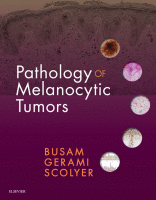Physical Address
304 North Cardinal St.
Dorchester Center, MA 02124

The term superficial spreading melanoma (SSM) is commonly used to refer to melanomas characterized by a combination of clinical and histopathologic findings. They usually occur at intermittently sun-exposed sites, manifest as peripherally spreading surface lesions, and display an intraepidermal growth…

Nomenclature Lentigo maligna melanoma (LMM) refers to a variant of melanoma that tends to occur on chronically sun-exposed skin of elderly Caucasians and is usually histopathologically characterized by a distribution of predominantly solitary units of melanocytes at the dermoepidermal junction.…

Microscopic examination and clinic-pathologic correlation represent the “gold standard” for the diagnosis of melanoma. Among experienced pathologists, the assessment of melanocytic lesions by histopathologic criteria is fairly accurate and reliable in most cases, but it cannot be expected to provide…

Pigmented epithelioid melanocytoma (PEM) is a rare melanocytic neoplasm composed of pigmented epithelioid and dendritic melanocytes with large vesicular nuclei. It was first described in patients with Carney complex under the rubric of epithelioid blue nevus. Carney complex is a…

Combined melanocytic nevi are benign melanocytic proliferations with two (or more) histopathologic nevus phenotypes in the same clinical lesion. Their clinical importance lies in the diagnostic pitfall they pose—their possible confusion with melanoma. Knowledge of the clinical and histopathologic spectrum…

Features of traumatized or persistent nevi appearing at the site of prior surgery may mimic melanoma, a phenomenon recognized for several decades. The histologic distinction between a persistent nevus and a regressing melanoma may in some cases, especially in partial…

Special site nevi or nevi with site-related atypia are terms used to describe melanocytic nevi located in some anatomic regions that, although benign, show unusual or atypical microscopic findings that may lead to diagnostic confusion with melanoma. A number of…

The so-called deep penetrating nevus (DPN) is a variant of a benign melanocytic nevus. It is composed of distinctive pigmented spindled, ovoid, or occasionally epithelioid melanocytes with a characteristically inverted triangle-like downward architecture. Its clinical significance lies in the potential…

Blue nevi (BN) and dermal melanocytoses share clinical, histologic, and molecular features. Clinically most lesions are characterized by bluish discoloration. Under the microscope there is an aggregate of melanocytes typically confined to the dermis unassociated with epithelium (i.e., there are…

The diagnosis of Spitz nevi and their distinction from melanoma is one of the most difficult tasks in neoplastic dermatopathology. Before a group of melanocytic proliferations was accepted as benign and named Spitz's nevus, similar lesions in children had been…